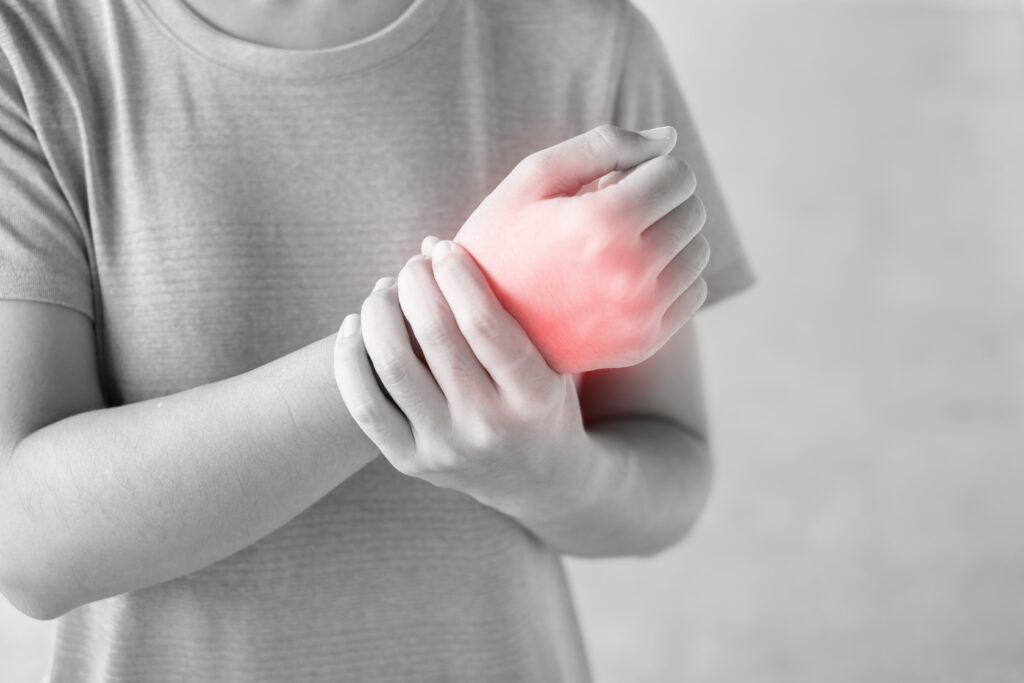
Hands-on Healing: The Power of Physical Therapy for Carpal Tunnel
By: Dr. Abe Kopolovich, DPT, MBA

Carpal Tunnel Syndrome (CTS) is a condition that affects the hand and wrist, causing pain, numbness, and tingling sensations. It is caused by pressure on the nerve at the base of the palm (median nerve) due to the constant demands people place on their hands and wrists.
While surgery is an option for severe cases, there are non-invasive treatments like physical therapy that can help alleviate the symptoms of Carpal Tunnel Syndrome. Keep reading to find out how this condition can be treated with a few exercises and changes to your routine.
What causes Carpal Tunnel Syndrome?
Carpal Tunnel Syndrome can be caused by a variety of factors, including repetitive hand and wrist movements, such as typing on a keyboard or using a phone. However, it is important to note that not everyone who performs these activities will develop this condition.
It is also common in professions such as assembly-line work (meat packing in particular). It also is common among people with jobs requiring the use of hand tools, especially tools that vibrate.
The following health conditions also may lead to Carpal Tunnel Syndrome in some people:
- Inflammation and swelling of the tendons of the wrist.
- Injuries to the wrist (strain, sprain, dislocation, fracture).
- Hormone or metabolic changes (pregnancy, menopause, thyroid imbalance).
- Fluid retention.
- Diabetes.
- Medications (such as steroids or chemotherapy).
- Degenerative and rheumatoid arthritis.
Symptoms of Carpal Tunnel Syndrome

Carpal Tunnel Syndrome usually starts gradually. This syndrome is characterized by waking up with numbness, tingling, or burning in their thumb, index, and middle fingers. Sometimes, the ring finger is affected.
As the condition worsens, the symptoms become more noticeable during the day. Symptoms often are worse when:
- Grasping heavy objects.
- Using a computer.
- Holding a cell phone.
- Gripping anything for a long period of time.
Hand weakness and more constant numbness may occur if the pressure on the nerve continues. You may find that you drop objects unexpectedly.
Does Physical Therapy Help Carpal Tunnel?
While Carpal Tunnel Syndrome is not always permanent, it is important to seek treatment as soon as possible to prevent further damage and improve symptoms.
Physical therapy can help individuals with Carpal Tunnel Syndrome manage their pain and improve their hand and wrist function through a combination of nerve gliding exercises, strengthening exercises, and modalities such as ultrasound and electrical stimulation.
There are also treatments for Carpal Tunnel Syndrome that can be done at home, such as taking frequent breaks from repetitive hand and wrist movements, wearing wrist splints to support the wrist and reduce compression, and practicing good posture to reduce strain on the neck and shoulders.
These are some Carpal Tunnel Syndrome Relief Exercises for patients in the early stages:

- Changing wrist positions (such as avoiding bent-wrist positions for long periods).
- Proper neck and upper-back posture (avoiding forward-head posture or slouching).
- Safety precautions when using sharp utensils, tools, or other implements. This is especially important if your physical therapist detects changes in your levels of feeling.
- “Stretch breaks” during your work or daily routine.
- Stretching and strengthening exercises.
Other treatments may include…
Splinting: Your physical therapist may recommend that you use a splint at night to reduce discomfort.
Cold and heat treatments: Your physical therapist may use cold or heat treatments, or recommend you use ice or heat to relieve pain.
They may also recommend options for your work, home, and leisure activities as part of your treatment plan.
Surgery for Carpal Tunnel Syndrome After Care

If the evaluation reveals that your Carpal Tunnel Syndrome is severe, or if your symptoms persist, your physical therapist may refer you to consult with a surgeon. If surgery is needed, the surgeon will release the band of tissue that forms the roof of the carpal tunnel. This will decrease the pressure on the median nerve.
Carpal tunnel physical therapy after surgery may include exercises to improve range of motion and flexibility, as well as modalities like ultrasound and electrical stimulation to reduce pain and promote healing.
Your physical therapy treatment after surgery may include:
- Scar management to keep the skin supple and flexible.
- Exercises to glide the nerve within the healing tunnel.
- Stretching exercises to improve mobility of the wrist and fingers and improve function.
- Strengthening exercises to improve the strength of the wrist and hand muscles and improve function.
- Education about proper posture and wrist position to avoid carpal tunnel compression in home/leisure activities.
- A work site visit or mock-up to show you proper workstation set-up.
Are you ready to get the best treatment for your carpal tunnel? Dr. Abe and the Therapy In Motion team are waiting for your call! Contact us now and book your first session towards wellness today.



